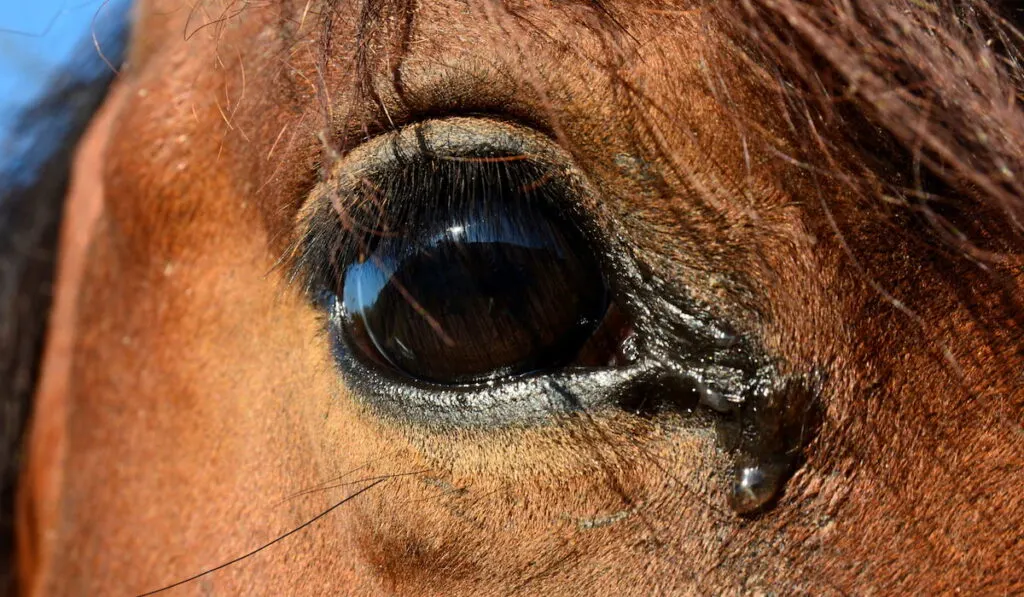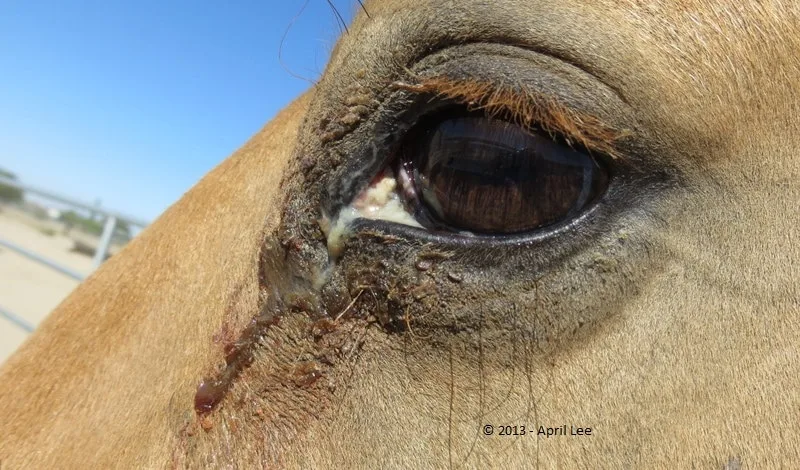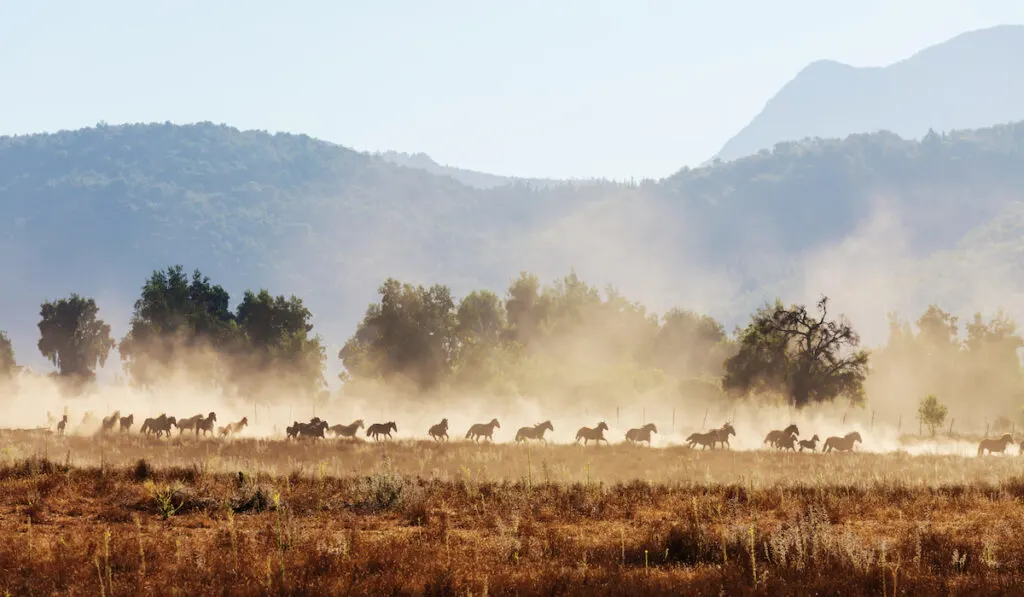One of the great things about horses is how much they connect with humans. They are intelligent, have distinct personalities and they experience emotions. So it is only natural to wonder if in fact horses cry as well. Do these magnificent animals shed a tear? Do horses cry with emotion, like us? Many people have even seen some horses with some wetness around the eye – but does that mean that horse was sobbing?
Do horses cry? The general answer for if horses cry is that no, they do not openly weep like people do. However, they do have functioning tear ducts that can come into play when there is an irritation.

So, to recap: sad tears are a no, but horses do shed tears to clear out an irritation or in response to an eye inflammation.
Table of Contents
The Physicality of Horse Tears
The reality of horses is that their tear ducts are totally functional. Where they differ from humans, is that their tears are the result of something physical, rather than reacting to something emotional.
Eye Irritants
For horses, tearing up has nothing to do with feeling sad and everything to do with an irritant. Just like people’s eyes water when there is a lash or something on the eyeball itself, so do horses react to any kind of debris. (source)
A horse that seems to be doing fine in all other regards (no lameness, no sores, no changes in behavior) but who constantly has tears running down his face may actually have a blocked tear duct, or nasolacrimal duct.
Blocked Tear Duct
This duct’s normal job is to drain excess tears from the eyes down through the nose, but, if it becomes blocked for any reason, those tears collect in the duct at the bottom of the eye and spill over the lid, running down the face.
Ducts can become blocked for a variety of reasons, from dust and particles in the air, to the mucus found in horse tears, to a horse simply genetically having narrower tear ducts. It can be an issue that a horse experiences from time to time or just a one and done situation for some horses.
This blockage can generally be fixed by a vet flushing the duct. A small tube is run up through the horse’s nose and into the end of the duct, which delivers a small squirt of saline solution.
Though it sounds like it might hurt, this is a painless procedure and usually clears out the blockage (think Drano or Liquid Plumber but for horse eyes). Fluid should bubble right up after a successful flush.
Random Eye Irritants
Horses may also tear up due to simple irritations. Dust in the air, fine particles of hay, even those pesky flies of all sizes are all environmental pains.
Think about how painful and frustrating it is when you get an eyelash or a speck of dirt in your own eye. Horses are no different when it comes to reacting to harmful irritations! And the best way to flush out a painful intruder is to cry it out.

Eye Infection
Another cause of horse tears can be an eye infection. A step further than an eye irritation, to be sure, but still a treatable reason for ‘crying.’ Conjunctivitis in equines is a bacterial infection and generally pronounces itself as a combination of swelling, irritation, and tears.(source)
When a horse’s eyes is infected, it will often swell tightly shut, creating an illusion of the bright pink mucous membranes lining the eyelid appearing to actually ooze out between the lids themselves.
If this is the case, the horse will likely already be experiencing sensitivity and so may be a bit touchy about having his eyelids examined.
The cause of an infection of a horse’s eye is typically any trauma to the tissues that surround the eye, as this essentially opens the gates for a bacterial invasion.
Flies
One example of this is when flies, who are attracted to the moisture a horse’s eye provides, swarm his face, leading the horse to rub against his leg or knee in an effort to push them off.
The insects may indeed leave, but any bacteria they were carrying with them remain and can be rubbed into the eyelid’s sensitive membranes. For this reason, you may see horses wearing fly masks in the summer months. Fly masks do not just protect horses from the annoying habits of flies, but also protect them from possible infections they bring.

Dust
Windblown dust, also an irritant, can go a step further by leading to rubbing and therefore infection. Conjunctivitis in horses is not an airborne condition, but, if there is a particularly strong strain, it can be spread by direct contact.
Treatment for conjunctivitis is fairly simple and can be found in the form of a topical antibiotic eye ointment, provided by a veterinarian. With treatment and removal of the irritant, the swelling of conjunctivitis should subside in about two days. You will see the horses’s tears subside and their eye go back to looking normal once more.
On more eye culprit of equine tears can be inflammation itself. An inflamed eye can go along with any number of issues, but it is the actual swelling (and irritated inflammation) that causes an eye to water. If your horse is tearing up because of an inflamed eye, it is a good idea to figure out the root cause of the inflammation itself.
Horse Stressors
While horses may not cry in response to sad or stressful situations as humans do, they do experience those emotions and psychological reactions. It is important to be aware of might be causing anxiety in a horse. While no two horses are exactly the same, there are certain situations that tend to weigh heavily across the pack.
Sudden environmental changes, like being moved to a new barn or even rotating to a new field can throw a horse off. They also are pack animals at heart so if a horse friend moves or passes, that can weigh heavily.
The same applies to their bond with their people – if they suddenly stop seeing their favorite human they’ve known and loved for years, it can hurt them.
Changes in routine, an injury, some troubling scent in the air – all these can affect a horse’s mental state. And, while some things are easily shrugged off, others can really take their toll on an animal.

How Horses Express Sadness, Pain, Etc.
You may not be able to see a horse cry in response to these stressors, but they do react. It is important to know that horses do not just show off when they are hurt or sad, mostly from an evolutionary needs – you do not want to signal out in the wild that you’re the weak one in the pack and something is wrong.
Signs that a horse may be experiencing some emotional trauma can include:
- Being off his feed (a distinct lack of or change in appetite, especially if it becomes accompanied by weight loss)
- Sluggish movements or a lack of interest in activities he usually loves (if your horse typically loves jumping and is a speedhog but is suddenly uninterested or slow to respond, that may be a sign that something is wrong)
- Irritability that is out of the ordinary (a usually mild horse suddenly pinning its ears back, snipping, stomping, etc.)
- Cribbing
- Stall Walking (aimless walking or circling in a stall)
- Teeth grinding
- Unusually high pulse or respiration rates
The main thing to be aware of is any changes in usual behavior. A horse may not cry, but they do feel. Keep your horse well-loved and consult your vet if anything out of the ordinary persists.

